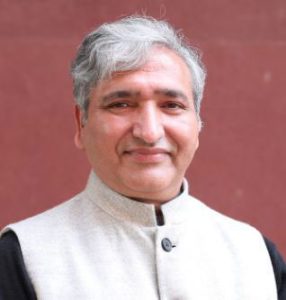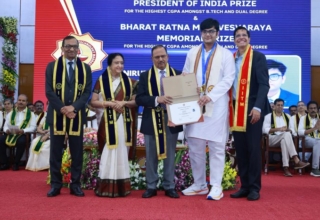
UGC’s New Internationalization Regulations on Twinning, Joint Degree and Dual Degree Programmes can potentially set in a revolution in India’s higher education
By Autar Nehru
Post liberalization, India’s straddle strategy of becoming a globally competitive higher education system with the help of foreign collaborations, has been accelerated by The University Grants Commission (Academic Collaboration between Indian and Foreign Higher Educational Institutions to offer Twinning, Joint Degree and Dual Degree Programmes) Regulations, 2022 which were notified on May 2.
Also, the promulgation of these regulations provides the much needed missing regulatory framework for scaling up these kind of joint academic programmes, as previously issues of credibility, accreditation and protection of student interests didn’t make them any popular among the average Indian. Broadly there was a lot of ambiguity in enabling regulations to safeguard the interest of students’ community in India and ensure uniform maintenance of norms and standards as prescribed by various statutory bodies, to enforce accountability and safeguard against entry of non accredited Universities /Institutions in the country of origin and also to safeguard the nation’s interest and take punitive measures, wherever necessary, against the erring institutions. So in that context, these regulations are a welcome development as now there are well defined parameters, objectives and clarity on roles.
It may be mentioned that the bulk of the twinning programs operational in India prior to this notification have been happening outside the existing regulatory arrangement and therefore lacked the benefits, rights and privileges of a regular degree/diploma holder.
Though these regulations existed in some form even before, still credit goes to the NEP-2020 which calls for permitting credits acquired in foreign countries to be counted for the award of a degree has been its basis. Furthermore, the budget announcement of 2021 also proposed regulatory mechanism to permit dual degrees, joint degrees and twinning arrangements. The Ministry of Education had also publicized the draft for public comments last year.
 The regulations were approved on April 22 in a virtual meeting of UGC where UGC chairman M Jagadesh Kumar said, “On February 1, 2021, a proposal for regulatory mechanism to permit these three kinds of programmes was made and UGC formed a committee which looked into all aspects on promoting collaboration between Indian and international higher education institutes (HEIs). The committee prepared draft regulations which were put up for public feedback on UGC website. After considerations from public feedback, the regulations were finalised.”
The regulations were approved on April 22 in a virtual meeting of UGC where UGC chairman M Jagadesh Kumar said, “On February 1, 2021, a proposal for regulatory mechanism to permit these three kinds of programmes was made and UGC formed a committee which looked into all aspects on promoting collaboration between Indian and international higher education institutes (HEIs). The committee prepared draft regulations which were put up for public feedback on UGC website. After considerations from public feedback, the regulations were finalised.”
On expected lines, after word about the notification spread, people have started showing interest and talking on how these regulations will dramatically impact collaborations with foreign HEIs and the growing study abroad segment itself. Several foreign universities have started looking at this development with great interest. UGC is also proactively persuading top universities by engaging various foreign missions in the capital New Delhi.
While it is too early to comment if these regulations will bring about a tectonic shift in the nature of current partnerships of Indian HEIs with the foreign HEIs, it is obvious that now the potential for cashing on rising aspirations ( both of students and universities) and internationalization as a result is quite high. From link programs, research collaboration, faculty and student exchange programs and twinning programs, the areas of collaboration have proportionally moved with pace of globalization in the past a few decades. And addition of this set of regulations can be well a defining moment of the last 40 years of debate on these reforms.
 “This is going to be huge. The students especially from tier 2 and tier 3 cities who have only seen their cousins, rich relatives and others from cities going abroad for study would themselves start dreaming about studying in these top universities. It is not fees but living cost in foreign universities that hurts so if same education is made available in India through these collaborations, it will make it affordable for thousands,” says Pawan Adhikari, Founder-CEO of Noida-based DP Cube Learning and Skills Private Limited, a startup specializing in study abroad and other education services.
“This is going to be huge. The students especially from tier 2 and tier 3 cities who have only seen their cousins, rich relatives and others from cities going abroad for study would themselves start dreaming about studying in these top universities. It is not fees but living cost in foreign universities that hurts so if same education is made available in India through these collaborations, it will make it affordable for thousands,” says Pawan Adhikari, Founder-CEO of Noida-based DP Cube Learning and Skills Private Limited, a startup specializing in study abroad and other education services.
 “Yes, Foreign HEIs recognize that there is opportunity in India beyond study abroad. They have been open to collaborations like joint degrees, credit transfers, twinning, and student exchange even in the past, but the regulatory environment wasn’t conducive. Now, they can operate these collaborations with more confidence,’ adds Anish Srikrishna Chief Executive Officer, Times Professional Learning.
“Yes, Foreign HEIs recognize that there is opportunity in India beyond study abroad. They have been open to collaborations like joint degrees, credit transfers, twinning, and student exchange even in the past, but the regulatory environment wasn’t conducive. Now, they can operate these collaborations with more confidence,’ adds Anish Srikrishna Chief Executive Officer, Times Professional Learning.
Globalization and access to international education has not only led to a kind of exodus among Indian students for pursuing higher education in foreign countries that we see in past decade, especially to Europe, US and elsewhere, but also in building a long-term knowledge and methodology expertise besides providing familiarity with foreign work culture and practices for partnering institutions.
 “These regulations are certainly welcome as we are living in an age of synthesis and collaboration where rewarding partnerships have become possible. It will also add to freedom and choice of students to pursue salutations oriented education. This will also improve the knowledge and working of Indian HEIs and prepare them to internationalisation mindset. And, most important from the student point of view, it will not only bring more choice but also save them from falling into trap of agents of shoddy foreign institutions,” says Prof Rajesh Khanna, President NIIT University, Neemrana (Rajasthan).
“These regulations are certainly welcome as we are living in an age of synthesis and collaboration where rewarding partnerships have become possible. It will also add to freedom and choice of students to pursue salutations oriented education. This will also improve the knowledge and working of Indian HEIs and prepare them to internationalisation mindset. And, most important from the student point of view, it will not only bring more choice but also save them from falling into trap of agents of shoddy foreign institutions,” says Prof Rajesh Khanna, President NIIT University, Neemrana (Rajasthan).
As Pawan Adhikari rightly says lack of research facilities in most Indian HEIs, access to better quality faculty and industry grade curricula is a big time challenge for higher education in India, Indian institutions stand to benefit as there will be a market push for these collaborations in next couple of years. While this is still short of allowing foreign HEIs in the country after an aborted attempt by UPA Government that brought the Foreign Educational Institutions (Regulation of Entry and Operations) Bill, 2010 and ultimately withdrew it under pressure of opponents, the current Government seems to have adopted a calibrated and pragmatic approach in this direction.
History
So, how did the history of these regulations begin? The real quest for a regulatory mechanism for twinning programs started in the 1990s decade after foreign education providers started entering into Indian market to promote diploma/degree programs in professional disciplines. Realising the urgency of situation, the Association of Indian Universities (AIU) formulated and issued guidelines regarding the grant of equivalence to degrees offered in India by foreign universities in 1999. Soon in April 2003 the All India Council for Technical Education (AICTE) issued regulations relating to entry and operation of Foreign Universities/Institutions imparting technical education in India. These were followed by The UGC (Promotion and Maintenance of Standards of Academic Collaboration between Indian and Foreign Educational Institutions) Regulations 2012.
Board criteria
Under these regulations only those Indian HEIs can enter into Twinning, Joint Degree and Dual Degree Programmes, which have NAAC accreditation with a minimum score of 3.01 on a 4-point scale at the time of application or have a NIRF ranking within top 100. Also, those Indian HEIs that figure in top 1000 rankings within international university rankings (Times Higher Education Rankings or QS World Rankings) are covered by these regulations in India now.
While as under the twinning programmes and joint degree programmes, the students will study at both collaborating HEIs with 30 per cent of the total credits earned from foreign HEIs, in dual degree programmes, the study has to study at 30 per cent of the total credits in home HEI. As the name suggests, under twinning the degree will be given by the Indian HEI, under joint programmes, one degree with joint signatures of the partnering HEIs and under dual degree programmes two degrees separately and simultaneously, upon completion of degree requirements of both the institutions. “The Degree awarded under these Regulations shall be equivalent to any corresponding degree awarded by the Indian Higher Educational Institution with the following stipulations: (i) there shall be no further requirement of seeking equivalence from any authority; and (ii) the degree shall have all benefits, rights and privileges as obtaining in the case of degree, awarded by an Indian Higher Educational Institution ordinarily,” says the new regulations while disallowing these kind of collaborations in open and distance mode .
Another welcoming aspect of these regulations has been institutionalization of the mandatory office of International Affairs (nodal cell) as a one point interface working as coordinating agency for collaborations, information as well as linked affairs of student mobility and others.
Future agenda
It is no secret that foreign universities always wanted to come to India given the size and potential of Indian market. Also, the share of contribution by international students to the economies of popular education destination countries is big and with Indian students’ at number 2 position after China, any related change that India will make will be noticed by these markets. The next big question is, will it impact the staggering number (750K in 2019) of students from India going abroad annually? The answer remains ‘No’ as that number will actually cross this year and until there is a this big gap in the GER in school education and higher education, this number is not going to come down in normal circumstances. The common joke that it is easy to get admission in Harvard but not in an IIM in India, unfortunately, remains a reality for many students in India who have aspirations of good education-driven careers.
While the regulations free city of GIFT (Gujarat International Finance Tech-City) which allows opening foreign university branches is a model to watch for, the biggest speculation is that FEIs will be finally allowed entry into India as a committee is already discussing that.
A suggestion is that the new regulations on Twinning, Joint Degree and Dual Degree Programmes, which is limiting the cohort of partnering institutions with stringent criteria of NAAC accreditation, can be relaxed to allow more universities to take this route and improve higher education in the country. With time, as a natural law of progression, surely more changes and amendments will be sought, but one thing is vry much clear, these regulations, are likely to kick-start a new phase in the journey of Indian higher education sector. Who know it may turn a new revolution.










